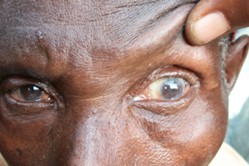Mass drug treatment for trachoma and scabies
Australian researchers have partnered with researchers in the Solomon Islands to prove it is possible to safely treat large populations for trachoma (an infectious disease which causes a roughening of the inner surface of the eyelids which can lead to pain in the eyes, breakdown of the outer surface or cornea of the eyes, and eventual blindness) and scabies (a skin infestation) simultaneously.
For the study an entire population (26,000-plus) in the Choiseul province of Solomon Islands was given antibiotics to treat these highly infectious neglected tropical diseases. The research, a collaboration between Murdoch Children’s Research Institute (MCRI), the Kirby Institute at UNSW Sydney, the Solomon Islands Ministry of Health and Medical Services, and the London School of Hygiene and Tropical Medicine is published in Lancet Global Health.
Professor Andrew Steer, from the Murdoch Children’s Research Institute and the University of Melbourne, said administering the two antibiotics together had significant advantages – reducing costs and the burden on health services and the community; and ultimately leading to better disease control. “We know from our previous research in Fiji that administering the antibiotic ivermectin to entire communities reduced the prevalence of scabies by 94 per cent,” Prof Steer said. “This new study shows that by adding azithromycin, we have the potential to double the bang for our buck and create high population-wide reductions in both scabies and trachoma at the same time.”
The Kirby Institute’s Lucia Romani, lead author on the paper, said scabies and trachoma were both recognised by the World Health Organisation as neglected tropical diseases, and responsible for significant disease in the Solomon Islands, and the Pacific region more broadly. “Both scabies and trachoma are very easily treated by the antibiotics, ivermectin and azithromycin,” Dr Romani said. “This research indicates that there is now a need for new studies to assess the safety and effectiveness of co-administration of treatments.



























